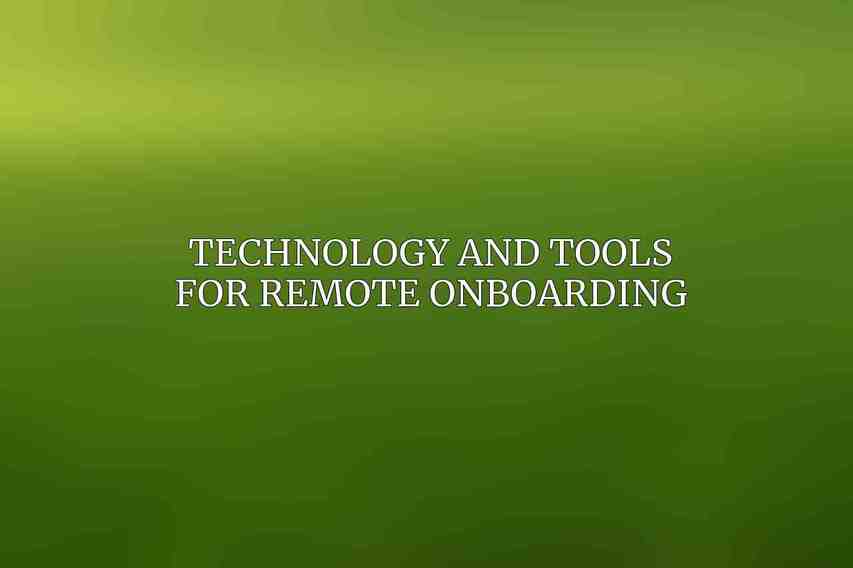The world of remote work has seen significant growth in recent years, with more companies embracing the concept of remote teams. Remote team onboarding presents both benefits and challenges, requiring a unique approach compared to traditional in-person onboarding. One of the key advantages of remote onboarding is the ability to tap into a global talent pool and provide employees with flexibility in their work environment. However, challenges such as maintaining communication, building a sense of belonging, and ensuring productivity can arise. Get the scoop on our perspective regarding Mastering Asynchronous Communication in Remote Teams
When it comes to successful remote onboarding, there are key principles that organizations should adhere to. Clear communication, structured training, and proactive support are essential components of a successful onboarding process. Planning and preparation play a crucial role in laying the foundation for a seamless onboarding experience. By having a well-thought-out onboarding strategy in place, organizations can set their remote team members up for success from day one.
Pre-Onboarding
A. Recruitment and Selection for Remote Roles
Recruiting for remote roles requires a keen eye for candidates who not only possess the necessary skills and qualifications but also demonstrate a high level of self-motivation, adaptability, and communication skills. Assessing candidates for their ability to thrive in a remote setting is paramount during the selection process.
B. Pre-Employment Communication and Welcome Package
Prior to the first day, it’s crucial to keep the lines of communication open with new hires. Providing them with a detailed welcome package that includes information about the company culture, expectations, and onboarding schedule can help ease any pre-onboarding jitters and set a positive tone for their arrival.
C. Setting Expectations and Providing Pre-Onboarding Materials
Clearly outlining what is expected of new employees from the onset is key to setting them up for success. Providing pre-onboarding materials such as company policies, training resources, and access to necessary tools can help new hires feel prepared and informed before they start their role.
D. Equipment and Technology Requirements
Ensuring that new team members have the necessary equipment and technology to perform their job effectively is crucial. Providing guidance on setting up workstations, access to company software, and technical support can prevent any delays in productivity on the first day.
Day One Onboarding
A. Virtual Welcome and Introductions
The first day of onboarding sets the tone for the new team member’s experience. A virtual welcome session that includes introductions to key team members, an overview of the company culture, and an outline of the onboarding agenda can help new employees feel welcomed and integrated from the start.
B. Virtual Workspace Setup and Training
Assisting new hires with setting up their virtual workspaces, including access to communication tools, project management platforms, and necessary software, is essential for a smooth transition into their role. Providing training on how to navigate these tools ensures that employees can hit the ground running.
C. Establishing Communication Channels and Tools
Establishing clear communication channels and guidelines from day one is crucial for remote teams. From team chat platforms to video conferencing tools, ensuring that new hires are familiar with and comfortable using these technologies fosters effective collaboration and connectivity within the team.
D. Job Role and Responsibilities Overview
Providing new team members with a comprehensive overview of their job role, responsibilities, and goals aligns expectations and sets a clear path for success. Clarifying performance metrics and expectations early on can help remote employees understand how their contributions contribute to the overall team objectives.
Comprehensive Onboarding Plan
A. Week 1: Fundamental Training and Shadowing
focus on providing new hires with fundamental training on company policies, procedures, and culture. Pairing them with a mentor or buddy for shadowing can help them quickly acclimate to their role and the team dynamics.
B. Week 2: Role-Specific Deep Dive
During the second week, delve deeper into the specifics of the new team member’s role. Providing detailed training on job-specific tasks, expectations, and key performance indicators sets the foundation for success in their position.
C. Week 3-4: Project Collaboration and Integration
Encouraging new hires to actively participate in team projects and collaborate with colleagues fosters a sense of teamwork and integration. Providing opportunities for hands-on involvement in projects allows employees to apply their skills in a practical setting and build relationships with their peers.
D. Week 5-8: Performance Evaluation and Feedback
Regular performance evaluations and feedback sessions in the initial weeks allow for continuous improvement and alignment with organizational goals. Providing constructive feedback, recognizing achievements, and addressing any challenges early on can help remote team members thrive in their roles.
Culture and Integration

A. Virtual Team Building Activities
Engaging in virtual team building activities such as online games, virtual coffee breaks, or team challenges can help remote employees feel connected and foster a sense of camaraderie despite physical distance. Building a strong team culture through shared experiences is vital for remote team cohesion.
B. Remote Team Communication Strategy
Establishing a robust communication strategy that includes regular team meetings, one-on-one check-ins, and virtual social gatherings is essential for keeping remote teams engaged and connected. Clear communication channels and guidelines promote transparency and collaboration within the team.
C. Fostering a Sense of Belonging and Connection
Creating opportunities for remote team members to share personal stories, interests, and experiences can foster a sense of belonging and connection within the team. Encouraging open communication and providing platforms for team members to interact on a personal level can strengthen relationships and build a supportive work environment.
D. Access to Resources and Information
Ensuring that remote employees have easy access to relevant resources, information, and support systems is crucial for their success. Providing a centralized hub for policies, training materials, and FAQs can empower employees to find the information they need efficiently and independently.
Technology and Tools for Remote Onboarding

A. Video Conferencing Platforms
Utilizing video conferencing platforms such as Zoom, Microsoft Teams, and Google Meet enables seamless communication and collaboration among remote team members. These tools facilitate virtual meetings, training sessions, and team interactions effectively.
B. Collaboration and Project Management Tools
Tools like Asana, Trello, and Slack streamline project management, task assignments, and team communication in remote settings. Leveraging these platforms enhances productivity, transparency, and organization within remote teams.
C. Virtual Workspace Providers
Virtual workspace providers like Citrix Workspace, Microsoft Teams, and Virtual Desktop Infrastructure (VDI) solutions offer secure and efficient remote work environments. These platforms ensure data privacy, accessibility, and seamless collaboration for remote team members.
D. Employee Engagement and Performance Management Systems
Employee engagement and performance management systems such as 15Five, Culture Amp, and BambooHR help organizations measure employee engagement, provide feedback, and track performance remotely. Implementing these systems enhances communication, accountability, and employee development in remote teams.
Continuous Support and Development
A. Regular Check-Ins and Feedback Sessions
Conducting regular check-ins and feedback sessions with remote team members fosters open communication, clarifies expectations, and addresses any challenges in a timely manner. Providing constructive feedback and support enables remote employees to thrive and grow in their roles. See our take on Engaging Virtual Team Building Activities for Remote Teams
B. Mentorship and Coaching for Remote Team Members
Pairing remote team members with mentors or coaches who provide guidance, support, and professional development opportunities can enhance their skill development and job satisfaction. Mentorship programs create a culture of continuous learning and growth within remote teams.
C. Access to Training and Development Programs
Offering remote team members access to training and development programs, workshops, and upskilling opportunities demonstrates a commitment to their professional growth and career advancement. Investing in continuous learning empowers remote employees to enhance their skills and contribute effectively to the organization.
D. Performance Reviews and Career Path Planning
Conducting regular performance reviews and career path planning sessions with remote team members allows for goal setting, feedback exchange, and alignment of individual objectives with organizational goals. Providing opportunities for career progression and skill development motivates remote employees to excel in their roles.
Ensuring Success in Remote Team Onboarding
A. Adapting to the Changing Landscape of Remote Work
Adapting to the evolving world of remote work requires flexibility, innovation, and a proactive approach to onboarding. Staying abreast of remote work trends, employee preferences, and technological advancements allows organizations to adapt their onboarding strategies effectively.
B. Measuring the Effectiveness of Onboarding Programs
Regularly assessing the effectiveness of remote onboarding programs through feedback, surveys, and performance metrics enables organizations to identify areas for improvement and optimize the onboarding experience. Monitoring key performance indicators and employee satisfaction levels helps gauge the success of onboarding initiatives.
C. Best Practices and Lessons Learned
Sharing best practices, success stories, and lessons learned from remote onboarding experiences across the organization fosters knowledge sharing and continuous improvement. Leveraging insights and feedback from both new hires and existing employees allows for refinement and enhancement of onboarding processes.
D. The Role of Technology and Automation in Onboarding
Utilizing technology and automation tools to streamline onboarding processes, automate administrative tasks, and enhance communication efficiency is instrumental in remote team onboarding. Leveraging digital solutions enables organizations to deliver a seamless and engaging onboarding experience for remote employees.
remote team onboarding in 2024 requires a strategic and holistic approach that prioritizes communication, connection, and support for new hires. By following the key principles outlined in this guide, organizations can create a positive onboarding experience that sets remote team members up for success in their roles. Embracing technology, fostering a strong team culture, and providing continuous support are essential pillars of effective remote team onboarding strategies.
Frequently Asked Questions
What are the key steps to successfully onboard remote team members?
The key steps include setting clear expectations, providing necessary tools and resources, scheduling regular check-ins, fostering a sense of belonging, and offering continuous training and support.
How can remote team members stay connected with the rest of the team?
Remote team members can stay connected through regular video calls, virtual team-building activities, instant messaging platforms, and collaborative project management tools.
What are some common challenges when onboarding remote team members?
Common challenges include communication barriers, feelings of isolation, difficulties in understanding company culture, technical issues, and time zone differences.
How can companies ensure the smooth integration of remote team members into their teams?
Companies can ensure smooth integration by providing comprehensive onboarding materials, assigning a dedicated mentor, facilitating team introductions, and offering ongoing support and feedback.
What are the best practices for onboarding remote team members in 2024?
The best practices include implementing a structured onboarding process, leveraging technology for seamless communication, fostering a culture of transparency and accountability, and prioritizing continuous learning and development.

